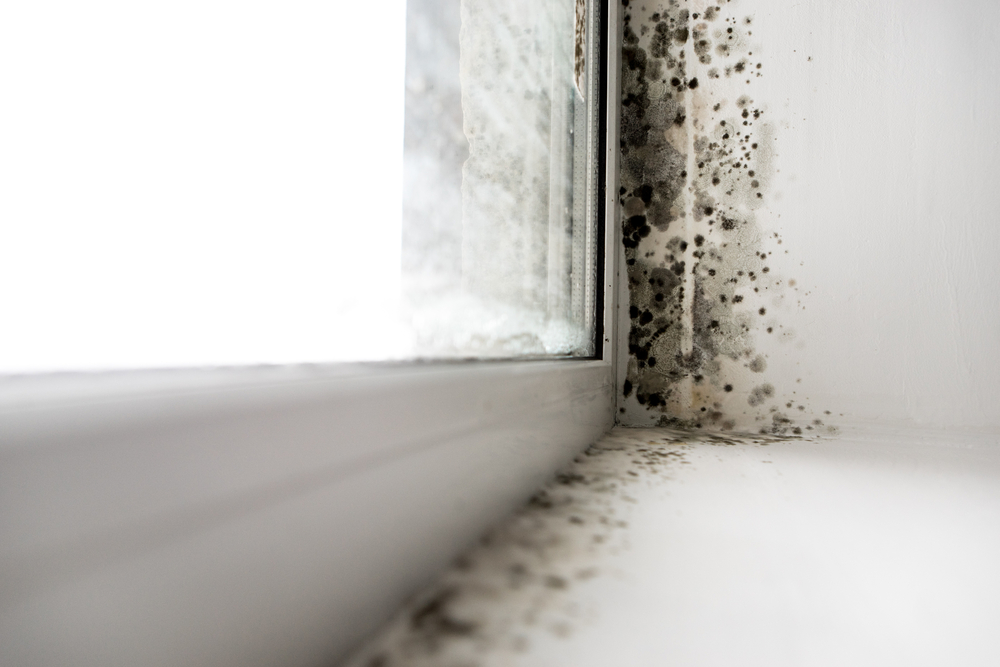The most common causes of mould growth are:
- Excess humidity inside the houses.
- Insufficient ventilation (or even none at all).
- Temperature excessively low as room temperature.
Mould protection for houses and homes
The development of mould can, in most cases, be prevented or alleviated by following a few rules regarding the correct use of ventilation and heating.
Mould in the rooms
The average adult - through breathing and perspiration - produces approximately 25 cl of moisture during a night's sleep. This humidity is produced in the form of steam, saturating the air in the room and condensing it in the coldest parts (corners, window panes, concrete beams, etc.).
Unless the room is ventilated at night, this tends to lead to mould growth on the corners of the walls, behind the furniture, and around the windows.
Inadequate living habits related to heating and ventilation can cause health problems, such as chronic respiratory tract infections.
To prevent or improve these problems, care must be taken to ensure a permanent flow of fresh air, although this does not normally happen in main rooms. Sufficient air exchange can be ensured by opening a window at night, while leaving the door to the main room open.
In the morning, the window should be fully open for a quarter of an hour with the radiator off, while the bed is aired. (During cold spells, the window should be closed and the heat used.)
Mould in wall cabinets
People often contact us to report damp and mould in cabinets. A closet is a space - often nearly airtight - for the storage of clothes and other objects. Theoretically, clothes are dry, but they often still contain small amounts of moisture which evaporates in a cold, poorly ventilated space and creates mould and moisture problems. This is an easy problem to solve:
- Creation of ventilation holes.
- The doors can be equipped with “Venetian blinds” (as long as they are not hermetic).
- The wall cabinets can also be ventilated by a rear hatch.
The most important thing is to make sure your clothes are completely dry before putting them in closets.
Mould in bathrooms
Bathrooms produce more water vapor than any other room in the house. This is why mould is normally found there.
There are three simple and basic ways to avoid this problem:
- Keep the door closed when using the shower or bathroom to prevent moisture from spreading to adjoining rooms.
- Open the window at a 90-degree angle for an hour immediately afterwards, but leaving the door tightly closed, to keep moisture from stagnating and condensing inside the bathroom.
- When the bathtub is filled, to produce less water vapor, fill the bottom of the bathtub with +/- 3 cm of cold water first and add hot water later.
The following tips can also be very helpful:
- Install an electric fan (exhaust fan) in the bathroom linked to the light switch, accompanied by a ventilation grille at the bottom of the bathroom door.
- Bathrooms should be painted with washable paint, which is less favorable to mould growth than traditional paints.
The fungus on the edges of the tiles can be removed with soapy water and small amounts of bleach.
Mould in kitchens
The mould in the kitchen is often the result of misuse - or not use - the hood. Kitchens should be equipped with range hoods designed to draw air to the outside.
The exhaust hoods should be left on for at least fifteen minutes after the production of any steam.
Mould in basements
Basements should be equipped with natural ventilation that includes two ducts, front and rear, if possible. Very humid basements should be equipped with fans connected to a time switch to ensure forced ventilation of the basement.
Mould on household linen
Drying the underwear in the house is highly recommended, since it considerably increases the humidity. Instead:
- Dry all clothes outside.
- Use an electric clothes dryer equipped with a steam exhaust duct to the outside.
- If this is not possible, any room used for drying clothes must be equipped with a dehumidifier.
An effective solution to combat mould
If all these precautions cannot solve the problem, call our mould inspection team to inspect your house thoroughly and find the cause of the moulds and give you professional solution on how to get rid of it.



Comments
Post a Comment